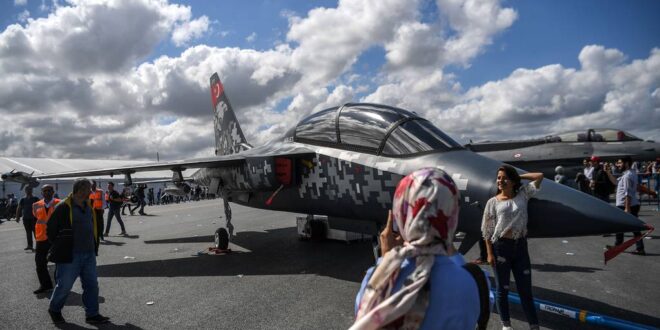The Turkish government has given the go-ahead for the mass production of the country’s indigenous basic trainer and light-assault aircraft.
The decision for serial production of the Hurjet was taken at a Jan. 12 meeting of Turkey’s ultimate decision-maker on defense procurement, the Defence Industry Executive Committee. The meeting was chaired by President Recep Tayyip Erdoğan.
Turkish Aerospace Industries, which makes the aircraft, did not disclose how many would be produced under the first serial production plan.
The armed trainer Hurjet is a jet engine version of the turboprop Hurkus. TAI launched the Hurjet program in 2018, with an original target of having the aircraft’s maiden flight in 2022. The company is planning Hurkus’ maiden flight in 2023.
Turkish procurement officials think that once the Hurjet has become combat-proven through its use by the Turkish military, export prospects will flourish.
“Ongoing negotiations [for exports] have been a booster in formalizing the government’s intention to start serial production,” a procurement official said.
Late last year, Niger became the first foreign customer of the Hurkus. Turkey’s Caucasus ally Azerbaijan will likely become the second foreign customer. In December, a Hurkus underwent a flight test in Azerbaijan, according to Turkey’s ambassador to Baku, Cahit Bağcı. Azerbaijan’s Air Force commander, Lt. Gen. Ramiz Tahirov, was present for the event.
Also in December, TAI made a presentation in Qatar’s capital Doha to sell the aircraft to the Turkish ally.
TAI is also a contender, with its Hurjet, in a Malaysian competition for 18 light-assault aircraft.
The Hurjet is to have a maximum speed of Mach 1.2 and can fly at a maximum altitude of 45,000 feet. The aircraft’s design is for a maximum payload of 3,000 kilograms, including ammunition, radar technology and a camera.
TAI said the Hurjet is meant to replace aging Northrop Grumman T-38 Talon aircraft currently used by the Turkish Air Force.
Hurkus-C, the armed variant of the base version of Hurkus, features locally developed ammunition including CIRIT, TEBER, HGK and LGK. It can also use inertial navigation system/GPS-guided bombs, conventional bombs, non-guided rockets, and machine guns.
The armed Hurkus also features armored body parts, a self-protection system, a data link, laser tacking, an electro-optical and infrared pod, an external fuel tank, and advanced avionics.
With a 1,500-kilogram payload that can be used through seven external hardpoints, the Hurkus-C can perform light-attack and armed reconnaissance missions.
 Eurasia Press & News
Eurasia Press & News



